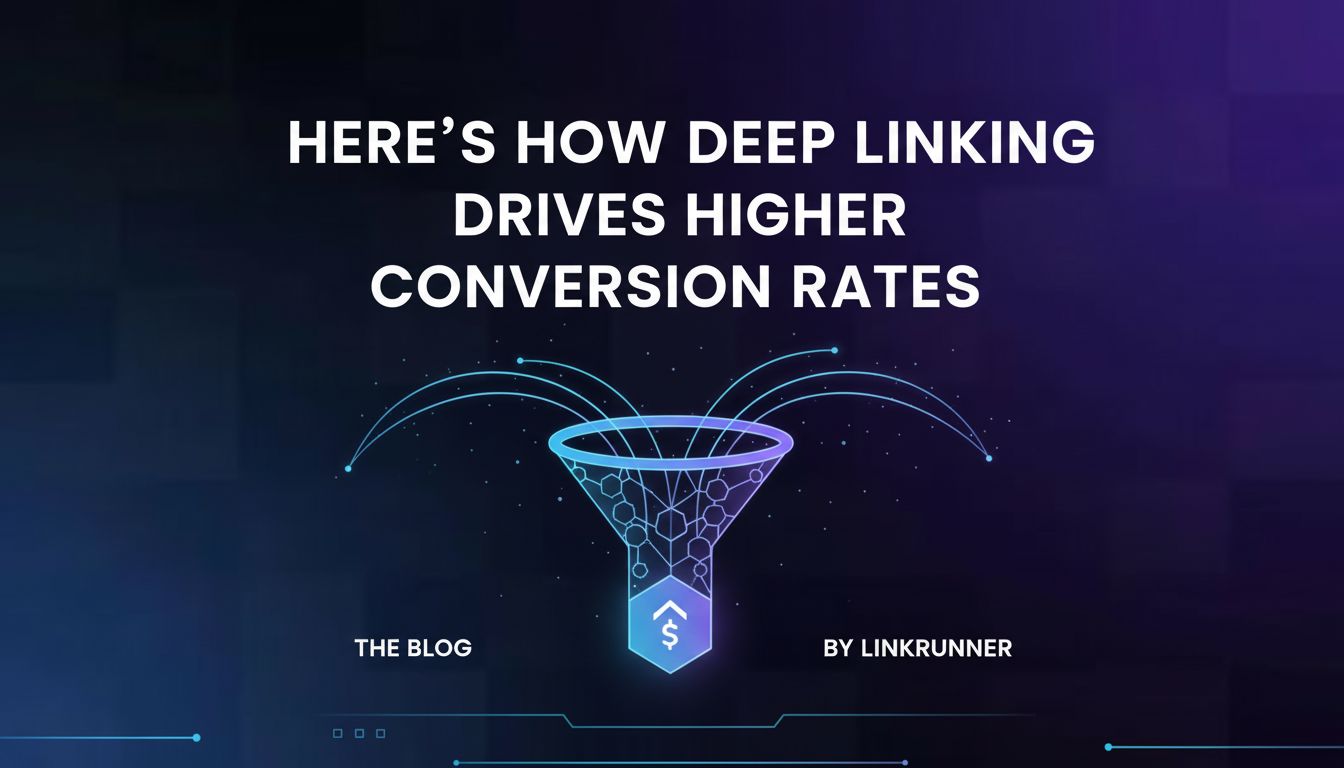When to Migrate from OneLink.to to Linkrunner (And How)


Lakshith Dinesh
Updated on: Dec 12, 2025
You launched with OneLink.to because you needed quick app routing without the complexity of a full mobile measurement partner. It worked for basic link management. But as your user acquisition scaled, you hit the ceiling. Attribution is guesswork. iOS campaigns are black boxes. Your team is stitching together three tools to answer one question: which campaigns actually drive revenue? If this sounds familiar, it's time to migrate to Linkrunner for complete attribution, deep linking, and ROAS visibility.
5 Clear Signs It's Time to Migrate to Linkrunner
Sign #1: You're Spending on Paid Ads Without ROAS Visibility
The Problem: You're investing thousands in Facebook, Google, and TikTok ads, but you can't definitively connect spend to revenue. Which creative drove purchases? Which audience segment has the highest LTV? OneLink.to shows clicks, not conversions or revenue.
What Linkrunner Solves: Full attribution tracking with server-to-server postbacks to ad networks. See campaign ROAS, creative performance, and cohort revenue in real-time, not weeks later in spreadsheets.
Sign #2: Your iOS Campaigns Are Unmeasurable
The Problem: Apple's ATT framework killed your iOS attribution. OneLink.to doesn't support SKAdNetwork, so you're flying blind on 50%+ of your mobile users. You can't optimize iOS campaigns because you don't know what's working.
What Linkrunner Solves: Native SKAN 4.0 integration with conversion value mapping. Track iOS installs, in-app events, and revenue within Apple's privacy framework. Get deterministic attribution where OneLink.to offers nothing.
Sign #3: Poor Conversion Rates from Generic App Landings
The Problem: Users click your ads, land on the App Store, and bounce. No context, no personalisation, no deep linking to the specific product they clicked. Conversion rates are 15-20% lower than industry benchmarks.
What Linkrunner Solves: Smart deep linking routes users directly to relevant in-app content post-install. Show them the product they clicked, apply the promo code automatically, and boost conversion rates by 25-40% with contextual onboarding.
Sign #4: Can't Track Influencer ROI
The Problem: You're paying creators for shoutouts and promo codes, but attribution is manual and unreliable. Did @fitness_guru's story drive 500 installs or 50? You're making renewal decisions based on gut feel, not data.
What Linkrunner Solves: Unique tracking links per creator with full funnel visibility. See exactly which influencers drive installs, engagement, and revenue. Pay for performance, not impressions, with transparent ROI reporting per partnership.
Sign #5: You're Paying for Multiple Tools to Get the Full Picture
The Problem: OneLink.to for routing, Firebase for analytics, Adjust for attribution, Mixpanel for events. Your team is exporting CSVs, joining data manually, and still missing gaps. Total cost: $500-2,000/month across tools, plus engineering time.
What Linkrunner Solves: Unified attribution, analytics, and deep linking in one platform. Single SDK, one dashboard, complete visibility from click to revenue. Eliminate tool sprawl and reduce costs by 40-60% while improving data accuracy.
What You Gain by Migrating to Linkrunner
When you move from OneLink.to to Linkrunner, you're not just switching link management tools, you're upgrading to a complete mobile growth platform:
Real-time ROAS dashboards show campaign profitability within hours, not days
Deep linking increases post-install conversion by 25-40% with contextual routing
SKAN 4.0 support makes iOS campaigns measurable again with privacy-first attribution
Fraud prevention blocks install farms, click spam, and bot traffic automatically
Unified analytics replaces 3-4 tools with one source of truth
Ad network integrations send conversion data back to optimize campaigns automatically
Dynamic QR codes bridge offline-to-online with trackable print, TV, and event campaigns
How to Migrate: 5-Step Process
Step 1: Export & Audit (Day 1 - 1 Hour)
Start by documenting your current OneLink.to setup. Export all active links from your dashboard and note their routing rules. Create a spreadsheet mapping each link to its purpose: which campaign, what channel, expected behavior. Identify any custom parameters or UTM tags you're passing. This audit ensures nothing gets lost in migration and serves as your testing checklist later.
Step 2: Set Up Linkrunner (Day 1 - 2 Hours)
Create your Linkrunner account, the free tier covers most migration testing. Recreate your OneLink.to links with enhanced capabilities. For each link, configure attribution windows, deep link routing, and fallback behavior. Set up campaigns in Linkrunner's dashboard to organize links by channel (paid social, influencer, email, etc.). Connect your ad network accounts (Facebook, Google, TikTok) to enable postbacks. This foundation takes 2 hours but unlocks capabilities OneLink.to never offered.
Step 3: Install SDK (Day 1-2 - 30 Minutes)
Add the Linkrunner SDK to your iOS and Android apps. For iOS, add the framework via CocoaPods or Swift Package Manager. For Android, include the Gradle dependency. Initialize the SDK in your app launch sequence, typically in AppDelegate (iOS) or Application class (Android). Configure your deep link URI schemes and implement the routing logic to handle incoming links. The SDK is lightweight (under 200KB) and won't impact app performance.
Step 4: Test Everything (Day 2 - 2 Hours)
Quality assurance is critical. Test every migrated link on both iOS and Android devices. Verify click tracking fires correctly, attribution data populates in your dashboard, and deep links route users to the right in-app destinations. Test edge cases: what happens with an uninstalled app? Does deferred deep linking work post-install? Check that ad network postbacks are firing for test conversions. Run through your entire user acquisition funnel to catch issues before going live.
Step 5: Go Live (Day 3)
Switch your live traffic from OneLink.to to Linkrunner links. Start with a small percentage (10-20%) if you want to be cautious, or flip everything if testing was thorough. Monitor your Linkrunner dashboard closely for the first 48 hours. Check that attribution rates match expectations, conversion events are firing, and no campaigns are broken. Update any hardcoded links in ad creatives, email templates, and social media bios. Once stable, you can decommission your OneLink.to account.
Migration Checklist
Common Migration Concerns
"Will I Lose My Existing Links?"
No. Your OneLink.to links will continue working as redirects even after you migrate. However, they won't provide Linkrunner's attribution benefits. Best practice: keep OneLink.to active for 30 days while you update links in ads, emails, and social profiles. This prevents broken links during transition. For legacy links you can't update (like printed materials), you can redirect the OneLink.to domain to your new Linkrunner links.
"How Long Does It Take?"
Most teams complete migration in under 24 hours of actual work. Day 1: export data, set up Linkrunner, install SDK (4 hours). Day 2: testing and QA (2-3 hours). Day 3: go live and monitor (1-2 hours). Larger teams with complex routing rules or dozens of ad accounts might need 2-3 days. But the engineering work is minimal, this isn't a multi-week project.
"What If Something Breaks?"
Run both systems in parallel during testing. Keep OneLink.to active while you QA Linkrunner links with test traffic. If issues arise, you haven't switched production yet. Post-migration, if you discover a problem, you can instantly revert by swapping back to OneLink.to links while you debug. Linkrunner also has a rollback feature to restore previous configurations with one click.
"Is It Worth the Effort?"
Consider the cost of not migrating. If you're spending $10,000/month on ads with a 20% ROAS uncertainty, that's $2,000 in potential waste. Linkrunner's attribution could identify underperforming campaigns and boost efficiency by 15-30%. Most teams see ROI within the first month through fraud prevention alone, which OneLink.to doesn't offer. The migration effort (24 hours) pays back many times over.
Maximum ROI Scenario: What You Actually Gain!
Here's the math most apps don't realize until after migration. Let's analyze a realistic growth-stage app to show the true financial impact.
App Profile:
25,000 installs/month ($3.00 CPI)
$75,000 monthly ad spend across Facebook, Google, TikTok
E-commerce app with 10% install-to-purchase rate
$50 average order value
$5,000/month influencer budget
Split 50/50 iOS and Android
The Real Cost Comparison
What You're Actually Paying with OneLink.to:
OneLink.to subscription: $40/month (Team Plus for routing only)
Adjust or AppsFlyer for attribution: $1,000+/month (required for basic analytics)
Real monthly cost: $1,040/month minimum
What You Pay with Linkrunner:
25,000 attributed downloads (minus monthly 3,000 installs free) × $0.01 = $220/month
Everything included (attribution, deep linking, SKAN, fraud prevention)
Total cost: $220/month
You're already saving $820/month before calculating business impact!!!
FAQ: Migrating to Linkrunner
Q: How long does migration take?
For most apps, total migration time is 12-24 hours of actual work spread across 2-3 days. Day 1 covers setup and SDK integration (4 hours), Day 2 handles testing (2-3 hours), and Day 3 is go-live monitoring (1-2 hours). Complex setups with many ad accounts or custom attribution rules might need an extra day. Solo developers can complete it in a weekend; teams can parallelize and finish faster.
Q: Will migration break existing campaigns?
No, if done correctly. The key is parallel running, keep OneLink.to active while testing Linkrunner links. Don't switch production traffic until QA is complete. Most teams gradually migrate campaigns: start with 10% of traffic, verify everything works, then move remaining campaigns. If you follow the 5-step process and complete the checklist, your campaigns won't skip a beat.
Q: Do I need a developer?
Yes, but only for 30 minutes of SDK integration. A developer needs to add the Linkrunner SDK to your iOS and Android apps and configure deep link routing. The rest of migration: exporting links, recreating them in Linkrunner, connecting ad networks, is no-code work any marketer can handle. If your team built the app, they can integrate the SDK. Linkrunner provides step-by-step docs for both platforms.
Q: Can I run both tools in parallel?
Absolutely, and you should during migration. Use OneLink.to for production traffic while testing Linkrunner with controlled test campaigns. This "dual-run" approach eliminates risk, you're validating Linkrunner's tracking without exposing live campaigns to potential issues. Many teams run parallel for 1-2 weeks before fully switching, though most find they can confidently migrate within days once testing confirms everything works.
Q: What if I want to go back?
You can revert to OneLink.to anytime by swapping links back in your ad creatives and pausing the Linkrunner SDK. However, once you experience real attribution data, fraud prevention, and deep linking, teams rarely go back. Linkrunner offers a 14-day trial, so you can test risk-free. If it's not delivering value, there's no long-term contract locking you in.
Q: How much does Linkrunner cost?
Linkrunner offers a free tier for testing and small apps (up to 1,000 attributed installs/month). Paid plans start at $99/month for growing apps, with enterprise pricing for high-volume apps requiring custom attribution models. Compared to running OneLink.to ($0) plus a separate MMP ($300-$2,000/month), Linkrunner is cost-neutral or cheaper while offering more features. Most teams find they save money by consolidating tools.
Conclusion: The Best Time to Migrate
If you recognise even two of the five signs above, you're already losing money by delaying migration. The cost of staying on OneLink.to (unmeasured iOS campaigns, wasted ad spend, manual influencer tracking, poor conversion rates) far exceeds the 24 hours needed to migrate.
Your competitors are optimising with real attribution data while you're guessing. Every day you wait is another day of fraud you don't catch, campaigns you don't optimize, and revenue you can't measure.
Start your Linkrunner migration today with the free tier. Follow the 5-step process, use the checklist, and within 48 hours you'll have the attribution visibility that's been missing since iOS 14.5 broke your tracking. Need help? Linkrunner's migration support team guides you through every step.
The best time to migrate was last month. The second-best time is now.
Questions or corrections? Contact Linkrunner




